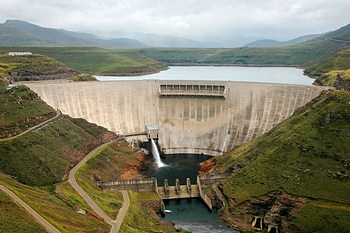Water is one of the country’s greatest natural resources. A new report based on SEI analysis shows new projects can boost domestic water security without compromising water exports.

The Lesotho Highlands Water Project (LHWP), a multi-stage infrastructure project that enables the transfer of water from Lesotho to Gauteng, South Africa, has facilitated investments of more than 3 billion USD and provided sustained revenues to the country, nearly 800 million USD since 1996.
Yet a lack of adequate infrastructure exposes Lesotho’s economy and households to a high degree of water insecurity, and future climate change could have important implications for water security.
Aiming to help the Government of Lesotho evaluate its options for achieving key development and climate resilience objectives, the World Bank conducted a detailed study of water resources in the country in the context of a changing – and highly uncertain – climate.
Annette Huber-Lee and Brian Joyce, both senior scientists in SEI’s U.S. Center, worked with Lesotho officials, the World Bank, and consultants to analyse the performance of different water infrastructure development strategies under 121 different climate scenarios, looking out to the year 2050.
The resulting report, Lesotho Water Security and Climate Change Assessment, finds significant opportunities for improving water security and supporting economic growth and poverty alleviation through new water infrastructure – while continuing to increase water transfers to South Africa.
“We welcome this very important work,” said Ralechate Mokose, Minister of Water for the Kingdom of Lesotho, in a World Bank press release. “It is the first of its kind and provides us with the evidence that will help us utilize our most valuable natural resource effectively in improving the lives of our people and to develop resilience against future climatic shocks.”
Simulations show that continued development of existing water infrastructure, such as the Lesotho Lowlands Water Supply Services (LLWSS) are critical to improving the reliability and resilience of the domestic and industrial sectors. They also show that exploring interconnections between the developed water resources through LHWP and linking these to address domestic and industrial demands in the lowlands could help improve the resilience of the existing system.

Furthermore, the implementation of the further phases of the LHWP will increase the transfer capacity and also support additional benefits, including the creation of about 11,000 construction jobs.
The report also finds that investing in irrigation could boost incomes and enhance food security, especially in an environment in which agricultural production is dependent on rain. Realizing the Government’s ambition for the development of 12,000 ha of irrigation could significantly impact crop production, with additional maize, beans, peas, sorghum, and wheat yields ranging of 70,000 to more than 100,000 tonnes per year. This would represent an increase of as much as 50%, depending on the climate scenario.
Guangzhe Chen, World Bank Country Director for Lesotho, noted in the press release that projected climate change is likely to have an impact on the long-term sustainable macroeconomic development of Lesotho, affecting domestic and industrial water security, patterns of agricultural production, and the opportunities afforded through the further development of water transfer infrastructure.

“Investing in monitoring and enhanced data acquisition will help improve future adaptive capacity and on-farm responses to changes in climate patterns and levels of variability,” said Marcus Wishart, a senior water resource management specialist at the World Bank who worked closely with the SEI team. He added that a more thorough assessment of the risks and opportunities posed by climate change in Lesotho is also essential.
The report also recommends improved data needed to continue to develop more sophisticated analyses of the complex issues around the country’s most important natural resource. Data constraints around agriculture, the economic uses and value of water, climate and hydrology have the potential to undermine future opportunities.
Huber-Lee said capacity-building has been one of the most important aspects of the work to date. “It has been transformative in the discussions, with the Lesotho partners taking ownership and asking new questions about why the water is allocated as it is, and about the relative benefits of different options,” she said.
Two teams in Lesotho have now taken over the modelling work, Huber-Lee said: one at the Lesotho Highlands Development Authority, which is charged with implementing the LHWP, and another based with the Water Commissioner of Lesotho. But she and Joyce will continue to travel to Lesotho and work with the government and with the World Bank.
“Continued investment in capacity-building and data collection is critical to provide policy-relevant recommendations in the context of a changing climate,” she said. “There is also a need to talk about water demand more widely across Southern Africa. Not only are there discussions under way about the next phase of the LHWP, but there is interest in transfers to Botswana. Lesotho needs to understand the trade-offs of keeping water for its own use vs. transferring it to other countries.”
Read an SEI/World Bank policy brief summarizing the study »
Read the World Bank press release (external link)
Design and development by Soapbox.